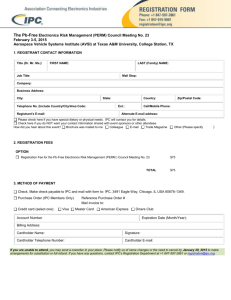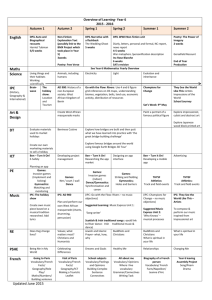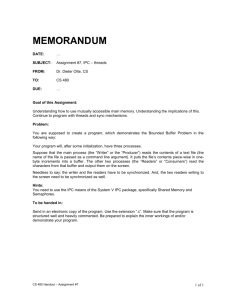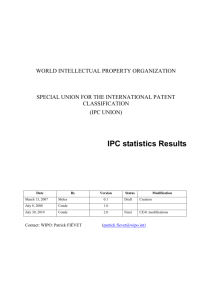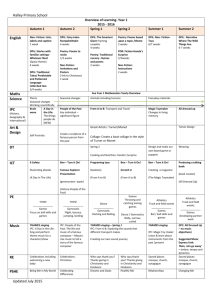Experimenting with Routing Policies using ProtoRINA over GENI Yuefeng Wang Ibrahim Matta
advertisement
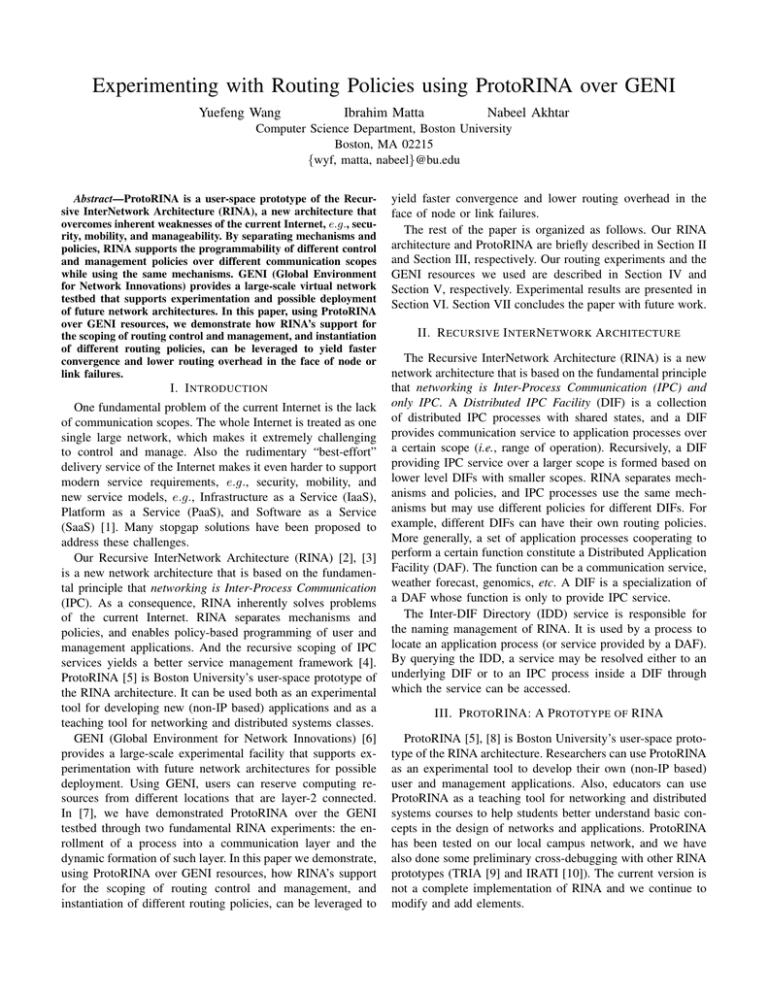
Experimenting with Routing Policies using ProtoRINA over GENI
Yuefeng Wang
Ibrahim Matta
Nabeel Akhtar
Computer Science Department, Boston University
Boston, MA 02215
{wyf, matta, nabeel}@bu.edu
Abstract—ProtoRINA is a user-space prototype of the Recursive InterNetwork Architecture (RINA), a new architecture that
overcomes inherent weaknesses of the current Internet, e.g., security, mobility, and manageability. By separating mechanisms and
policies, RINA supports the programmability of different control
and management policies over different communication scopes
while using the same mechanisms. GENI (Global Environment
for Network Innovations) provides a large-scale virtual network
testbed that supports experimentation and possible deployment
of future network architectures. In this paper, using ProtoRINA
over GENI resources, we demonstrate how RINA’s support for
the scoping of routing control and management, and instantiation
of different routing policies, can be leveraged to yield faster
convergence and lower routing overhead in the face of node or
link failures.
I. I NTRODUCTION
One fundamental problem of the current Internet is the lack
of communication scopes. The whole Internet is treated as one
single large network, which makes it extremely challenging
to control and manage. Also the rudimentary “best-effort”
delivery service of the Internet makes it even harder to support
modern service requirements, e.g., security, mobility, and
new service models, e.g., Infrastructure as a Service (IaaS),
Platform as a Service (PaaS), and Software as a Service
(SaaS) [1]. Many stopgap solutions have been proposed to
address these challenges.
Our Recursive InterNetwork Architecture (RINA) [2], [3]
is a new network architecture that is based on the fundamental principle that networking is Inter-Process Communication
(IPC). As a consequence, RINA inherently solves problems
of the current Internet. RINA separates mechanisms and
policies, and enables policy-based programming of user and
management applications. And the recursive scoping of IPC
services yields a better service management framework [4].
ProtoRINA [5] is Boston University’s user-space prototype of
the RINA architecture. It can be used both as an experimental
tool for developing new (non-IP based) applications and as a
teaching tool for networking and distributed systems classes.
GENI (Global Environment for Network Innovations) [6]
provides a large-scale experimental facility that supports experimentation with future network architectures for possible
deployment. Using GENI, users can reserve computing resources from different locations that are layer-2 connected.
In [7], we have demonstrated ProtoRINA over the GENI
testbed through two fundamental RINA experiments: the enrollment of a process into a communication layer and the
dynamic formation of such layer. In this paper we demonstrate,
using ProtoRINA over GENI resources, how RINA’s support
for the scoping of routing control and management, and
instantiation of different routing policies, can be leveraged to
yield faster convergence and lower routing overhead in the
face of node or link failures.
The rest of the paper is organized as follows. Our RINA
architecture and ProtoRINA are briefly described in Section II
and Section III, respectively. Our routing experiments and the
GENI resources we used are described in Section IV and
Section V, respectively. Experimental results are presented in
Section VI. Section VII concludes the paper with future work.
II. R ECURSIVE I NTER N ETWORK A RCHITECTURE
The Recursive InterNetwork Architecture (RINA) is a new
network architecture that is based on the fundamental principle
that networking is Inter-Process Communication (IPC) and
only IPC. A Distributed IPC Facility (DIF) is a collection
of distributed IPC processes with shared states, and a DIF
provides communication service to application processes over
a certain scope (i.e., range of operation). Recursively, a DIF
providing IPC service over a larger scope is formed based on
lower level DIFs with smaller scopes. RINA separates mechanisms and policies, and IPC processes use the same mechanisms but may use different policies for different DIFs. For
example, different DIFs can have their own routing policies.
More generally, a set of application processes cooperating to
perform a certain function constitute a Distributed Application
Facility (DAF). The function can be a communication service,
weather forecast, genomics, etc. A DIF is a specialization of
a DAF whose function is only to provide IPC service.
The Inter-DIF Directory (IDD) service is responsible for
the naming management of RINA. It is used by a process to
locate an application process (or service provided by a DAF).
By querying the IDD, a service may be resolved either to an
underlying DIF or to an IPC process inside a DIF through
which the service can be accessed.
III. P ROTO RINA: A P ROTOTYPE OF RINA
ProtoRINA [5], [8] is Boston University’s user-space prototype of the RINA architecture. Researchers can use ProtoRINA
as an experimental tool to develop their own (non-IP based)
user and management applications. Also, educators can use
ProtoRINA as a teaching tool for networking and distributed
systems courses to help students better understand basic concepts in the design of networks and applications. ProtoRINA
has been tested on our local campus network, and we have
also done some preliminary cross-debugging with other RINA
prototypes (TRIA [9] and IRATI [10]). The current version is
not a complete implementation of RINA and we continue to
modify and add elements.
A. RINA Node
As shown in Figure 1, a RINA node is a host (or machine)
where application processes and IPC processes reside. Application processes or high-level IPC processes communicate
with their peers using the communication service provided by
underlying low-level IPC processes, and the communication
service is provided through an IPC API.
In our current implementation of ProtoRINA, TCP connections are used to emulate physical connectivity between IPC
processes in level-0 DIFs. The emulation is provided by a
shim layer, which includes a virtual link (wire) manager in
each RINA node, and a RINA DNS server (connected to all
RINA nodes) that is able to resolve a user defined level-0 IPC
process’ name to an IP address and port number.
Our current implementation supports a centralized IDD
(responsible for naming management), and every RINA node
is connected to it. The mapping between an application process
(or high-level IPC process) to the lower level IPC process is
done by the underlying DIF.
DAF
Application Process
IPC
API
N Level
DIF
IPC Process (N Level)
N-1 Level
DIF
IPC Process (N-1 Level)
IPC
API
…
0 Level
DIF
IPC
API
IPC Process (0 Level)
IPC
API
Shim Layer
Fig. 1.
Virtual Link (Wire) Manager
RINA Node overview.
B. Configuration File
Each IPC process has a configuration file, which specifies
IPC process’ properties including name information, routing
policies, underlying DIF information, etc. The RINA node and
application process can also have their own configuration file.
The following are routing policies that are part of an IPC
process’ configuration file. In this example the IPC process
is instantiated with a link-state routing protocol, link-state
updates are sent to its neighbor processes every 10 seconds,
and the path cost is calculated using hop count. ProtoRINA
supports link-state routing and distance-vector routing.
rina . routing . protocol = linkState
r i n a . r o u t i n g E n t r y S u b U p d a t e P e r i o d = 10
r i n a . l i n k C o s t . p o l i c y = hop
Figure 2 shows the components of an IPC process and RINA
APIs that enable the programmability of routing policies. Each
IPC process has a Routing Daemon that is responsible for
routing inside the DIF, and a Resource Information Base (RIB)
that stores its view of all information related to managing
the DIF. The RIB Daemon helps other components access
information stored either in the local RIB through a RIB API,
or in a remote IPC process’ RIB by exchanging Common
Distributed Application Protocol (CDAP) [3] messages with
the remote IPC process. The IPC Resource Manager (IRM) is
responsible for managing the use of underlying IPC processes
through an IPC API and for creating and managing connections between IPC processes. CDAP messages are sent over
these connections through an IRM API.
RIB
RIB API
RIB
Daemon
IRM
API
RIB
Daemon
API
Routing
Daemon
RIB
Daemon
API
IPC Resource
Manager (IRM)
IPC
API
Fig. 2.
IPC process’ components and RINA APIs related to routing.
Based on a publish/subscribe model, the RIB Daemon
provides timely information to the management (application)
tasks of the DIF (DAF). Through the RIB Daemon API, the
Routing Daemon can easily access the information needed for
routing, such as link-state information from the IPC process’
neighbors. As mentioned earlier, different routing policies can
be set in the configuration file of the IPC process. Details of
ProtoRINA components and RINA APIs can be found in [5].
IV. D ESIGN OF ROUTING E XPERIMENTS
In our experiments, two application processes (App A and
App B) on two different RINA nodes (Node 1 and Node
2) would like to communicate with each other. There are six
other RINA nodes (Node A, Node B, Node C, Node
D, Node E and Node F) which are able to provide relay
service by building DIFs that include IPC processes on Node
1 and Node 2. We have a RINA node (Node DNS-IDD)
running the RINA DNS server and IDD server. We have run
experiments using two different DIF topology settings, but the
same physical connectivity between RINA nodes.
A. Simple one-level DIF topology
Node 2
Node1
App A
App B
Node A
Node B
Node C
IPC 2
IPC 3
IPC 4
IPC 5
IPC 1
IPC 6
IPC 7
IPC 8
Node D
Node E
Node F
DIF
Fig. 3.
App A and App B use a level-0 DIF consisting of eight IPC
processes.
In this first setting (shown in Figure 3), we have only one
large level-0 DIF consisting of eight IPC processes, and each
IPC process resides on one RINA node. App A communicates
with App B via the underlying level-0 DIF. App A and IPC
1 are on Node 1, and App A uses the communication service
provided by IPC 1. App B and IPC 5 are on Node 2, and
App B uses the communication service provided by IPC 5.
For the other six RINA nodes, IPC 2 is on Node A, IPC
3 is on Node B, IPC 4 is on Node C, IPC 6 is on Node
D, IPC 7 is on Node E, and IPC 8 is on Node F. Every
RINA node is connected to the RINA node (Node DNS-IDD)
running the RINA DNS server and IDD server, which are not
shown here.
First App A creates a connection to App B, and this
connection is mapped to a flow in the underlying DIF from
IPC 1 to IPC 5. Later App A starts sending messages to
App B, where messages arrive at App B through the flow in
the underlying DIF.
When an IPC process joins the DIF, it starts collecting
the link-state routing information of the DIF. After a while
the routing table of each IPC process converges. From IPC
1 to IPC 5 there are two paths with the same cost (using
hop count as path cost), and we assume that at first IPC
1 picks the path IPC 1 - IPC 2 - IPC 3 - IPC 4 IPC 5. So all messages from App A are sent over this path.
After a while we shut down Node C. Through the link-state
routing updates each IPC process soon learns of this change,
and their routing tables converge again. The path from IPC
1 to IPC5 adapts to IPC 1 - IPC 6 - IPC 7 - IPC
8 - IPC 5. During convergence of the routing tables, some
messages sent from App A to App B get lost due to path
failure. Once IPC 1 learns of the new path, the delivery of
messages at App B resumes.
B. Two-level DIF topology
In this second setting (shown in Figure 4) we have four
level-0 DIFs (DIF 1, DIF 2, DIF 3 and DIF 4), and
one level-1 DIF (DIF 5). App A communicates with App B
using the communication service provided by the underlying
level-1 DIF (DIF 5), which recursively uses the communication service provided by level-0 DIFs. DIF 1 has three
members IPC 1, IPC 2, and IPC 3. DIF 2 has three
members IPC 4, IPC 5, and IPC 6. DIF 3 has three
members IPC 7, IPC 8, and IPC 9. DIF 4 has three
members IPC 10, IPC 11, and IPC 12. DIF 5 has four
members IPC 13, IPC 14, IPC 15, and IPC 16.
Node 2
Node 1
App A
App B
the communication service provided by IPC 6 and IPC 7.
IPC 2 is on Node A. IPC 3, IPC 4, and IPC 14 are
on Node B, and IPC 14 uses the communication service
provided by IPC 3 and IPC 4. IPC 5 is on Node C.
IPC 11 is on Node D. IPC 9, IPC 10, and IPC 16 are
on Node E, and IPC 16 uses the communication service
provided by IPC 9 and IPC 10. IPC 8 is on Node F.
Every RINA node is connected to the RINA node (Node
DNS-IDD) running the RINA DNS server and IDD server,
which are not shown here.
Similar to the previous setting, App A first creates a connection to App B, and this connection is mapped to a flow in
the underlying DIF 5 from IPC 13 to IPC 15. Later App
A starts sending messages to App B, and messages arrive
at App B through the flow in the underlying DIF 5. From
IPC 13 to IPC 15 there are two paths with the same cost
(using hop count as path cost), and we assume that at first
IPC 13 picks the path IPC 13 - IPC 14 - IPC 15.
So all messages from App A will be sent over this path.
When we shut down Node C, then DIF 2 cannot provide
communication service between IPC 14 and IPC 15. This
causes the (virtual) link between IPC 14 to IPC 15 to go
down, which in turn makes the path IPC 13 - IPC 14 IPC 15 unavailable. Through routing updates inside DIF 5,
IPC 13 learns of this change and adapts to the new path IPC
13 - IPC 16 - IPC 15, then the delivery of messages at
App B resumes.
V. R ESERVING GENI R ESOURCES
In our experiments, we reserve GENI resources through
the GENI Portal [11]. The GENI Portal is a web tool that
allows users to manage their projects and reserve GENI
resources. Users can login to the GENI Portal using their
home institution’s credentials (username and password). After
logging in, the user can use tools such as Flack and omni to
reserve resources. We use Flack in our experiments.
Node B
DIF 5
IPC 14
IPC 15
IPC 13
IPC 16
Node A
IPC 2
IPC 1
Node C
IPC 3
DIF 1
IPC 5
IPC 4
IPC 6
DIF 2
IPC 12
IPC 7
IPC 11
IPC 10
IPC 9
IPC 8
Node E
Node F
DIF 4
DIF 3
Node D
Fig. 4. App A and App B use a level-1 DIF DIF 5 which is built on top of
four level-0 DIFs, and each level-0 DIF only consists of three IPC processes.
App A, IPC 1, IPC 12, and IPC 13 are on Node 1.
App A uses the communication service provided by IPC
13, and recursively IPC 13 uses the communication service
provided by IPC 1 and IPC 12. App B, IPC 6, IPC 7,
and IPC 15 are on Node 2. App B uses the communication
service provided by IPC 15, and recursively IPC 15 uses
Fig. 5.
GENI topology of nine virtual machines.
Figure 5 shows the network topology displayed in Flack
after we reserve nine virtual machines (VMs) from the NYU
aggregate. Each of the eight RINA nodes shown in Figure 3 or
Figure 4 corresponds to a VM. We have the RINA DNS server
and IDD server running on the ninth VM in the center of the
topology, and this RINA node is connected to all RINA nodes
to provide the directory service. After the VMs are reserved,
we SSH to each VM, upload our ProtoRINA code and run
our experiments. Each RINA node generates a log file, and
we obtain our experimental results by analyzing the log file.
4000
3500
1−level DIF
2−level DIF
160
Throughput (messages/sec)
140
100
80
60
40
20
5
10
15
20
25
Time (sec)
Fig. 6.
2500
2000
1500
1000
500
0
0
10
20
30
40
50
Time (sec)
Fig. 7.
Routing overhead at Node 2
From Figures 6 and 7, we can see that for a network with the
same physical connectivity, by building DIFs using different
topologies and different routing policies, we can achieve
shorter recovery times without increasing routing overhead.
We repeated our experiments on the NYU aggregate many
times, and observed similar results.
VII. C ONCLUSION AND F UTURE WORK
1−level DIF
2−level DIF
120
0
LSP (bytes)
3000
VI. E XPERIMENTAL R ESULTS
We run experiments on the GENI resources reserved
in Section V with the two DIF topology settings described in Section IV. We try different routing policies by
setting rina.routingEntrySubUpdatePeriod in the
IPC process’ configuration file to different values.
In the first setting, we have all eight IPC processes in
the underlying DIF send link-state routing updates to their
neighbor IPC processes every 10 seconds. In the second
setting, in the level-0 DIFs (DIF 1, DIF 2, DIF 3 and
DIF 4) we have all IPC processes send link-state updates
to their neighbor IPC processes every 10 seconds. But in the
level-1 DIF (DIF 5), we have all IPC processes send linkstate updates to their neighbor IPC processes every 5 seconds.
Instantaneous throughput at App B.
App A sends messages to App B at a constant rate of
10 messages/second. In Figure 6, we show the instantaneous
throughput starting from the time when App B receives the
first message from App A. We can see that after Node C goes
down, no new messages are delivered. Once the underlying
flow between App A and App B adapts to another path,
packet delivery resumes.
From Figure 6, we can see that in the second setting, routing
recovers faster than that in the first setting. This shows that
by building a higher level DIF with more frequent link-state
updates on top of small level-0 DIFs with less frequent linkstate updates, we can have a shorter recovery time.
We notice that message delivery exhibits a burst in a short
time after recovery. This is because some messages enter
in a routing loop between neighbor IPC processes whose
routing tables have not yet converged. Once all routing tables
converge, these messages get through to App B almost at the
same time with more out-of-order packets delivered under the
one-level DIF topology.
We also show the routing overhead at Node 2 over time
in Figure 7 by measuring the amount (in bytes) of linkstate packets received at Node 2. In the second two-level
topology, this overhead is due to the total link-state update
traffic received by IPC 6, IPC 7, and IPC 15 in their
respective DIFs. We can see that these two settings have almost
the same routing overhead at Node 2.
In this paper, we presented our experiments with different
routing policies using ProtoRINA. The experimental results
demonstrate that ProtoRINA provides a flexible platform for
managing a network as it provides policy holders where users
can set their own control and management policies.
We run our experiments on resources reserved from one
aggregate at NYU, and as future work we plan to run experiments on GENI resources from multiple aggregates. Also
we plan to set up a long-lived slice running ProtoRINA over
the GENI testbed, to enable researchers and educators to optin and benefit from the RINA architecture by experimenting
with policies for controlling and managing, not only routing,
but also enrollment, authentication, and data transfer.
ACKNOWLEDGMENT
We would like to acknowledge the support of the National
Science Foundation (NSF grant CNS-0963974) and the GENI
Project Office.
R EFERENCES
[1] National Institute of Standards and Technology, “The NIST Definition
of Cloud Computing,” 2011.
[2] Boston University RINA Lab, “http://csr.bu.edu/rina/.”
[3] J. Day, I. Matta, and K. Mattar, “Networking is IPC: A Guiding Principle
to a Better Internet,” in Proceedings of ReArch’08 - Re-Architecting the
Internet (co-located with CoNEXT), New York, NY, USA, 2008.
[4] Y. Wang, F. Esposito, I. Matta, and J. Day, “RINA: An Architecture
for Policy-Based Dynamic Service Management,” in Technical Report
BUCS-TR-2013-014, Boston University, 2013.
[5] ProtoRINA, “http://csr.bu.edu/rina/protorina/.”
[6] GENI, “http://www.geni.net/.”
[7] Y. Wang, F. Esposito, and I. Matta, “Demonstrating RINA Using the
GENI Testbed,” in Proceedings of the Second GENI Research and
Educational Experiment Workshop (GREE2013), Salt Lake City, UT,
USA, March 2013.
[8] Y. Wang, F. Esposito, I. Matta, and J. Day, “Recursive InterNetworking
Architecture (RINA) Boston University Prototype Programming Manual,” in Technical Report BUCS-TR-2013-013, Boston University, 2013.
[9] TRIA Network Systems, LLC, “http://www.trianetworksystems.com/.”
[10] The IRATI Project, “http://irati.edu/.”
[11] GENI Portal, “https://portal.geni.net/.”

